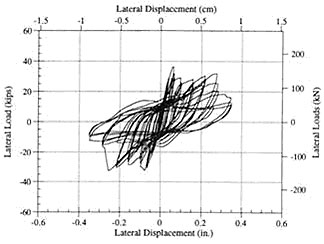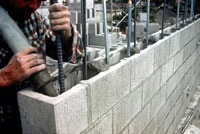Earthquakes Prompt Masonry Code Changes
Earthquakes are dramatic events. Sometimes, they occur unexpectedly or with very little warning. They are frequently short-lived and can pack strong forces into a short period of time. Earthquakes also place great accelerations onto structures. Their short durations notwithstanding, earthquakes can do extensive damage.

Typical force-displacement response of a masonry wall
Building codes are designed to provide protection of human lives and physical property. As codes have been shifting to consider longer periods of time over which events occur, there has been an increase in the magnitude of earthquakes being designed for, even though the likelihood of such an event occurring is decreased.
Various groups, such as The Masonry Society, have members who study building behavior during past earthquakes to learn as much as possible about structural performance of masonry subjected to seismic forces. They use that information to modify design criteria and building codes, making buildings safer.
Changing Masonry Building Requirements
The footprint of seismic zones is increasing and building requirements are changing. As a result, all buildings are expected to resist greater demands from potential seismic events. Existing masonry structures provide an opportunity to verify designers’ assumptions regarding structural response to seismic forces. Buildings that perform well demonstrate the effectiveness of a design methodology; buildings that perform less well make it possible to locate deficiencies and revise design approaches to improve structural behavior.
 There are two general classes of masonry structures: reinforced and unreinforced. Unreinforced masonry (URM) is less ductile than reinforced masonry, and ductile structures typically perform better in earthquake events. Surprisingly, however, studies of URM structures subjected to earthquakes have at times shown better performance than expected. Certainly, floor, roof and intersecting walls function as diaphragms, creating a more stable structure, like a box or cube. Studying unreinforced masonry buildings also provides clues as to how to best retrofit structures for improved future performance.
There are two general classes of masonry structures: reinforced and unreinforced. Unreinforced masonry (URM) is less ductile than reinforced masonry, and ductile structures typically perform better in earthquake events. Surprisingly, however, studies of URM structures subjected to earthquakes have at times shown better performance than expected. Certainly, floor, roof and intersecting walls function as diaphragms, creating a more stable structure, like a box or cube. Studying unreinforced masonry buildings also provides clues as to how to best retrofit structures for improved future performance.
Because of the reasons noted above, a larger number of contemporary masonry structures will be designed and built as reinforced structures. From a structural standpoint, taller, thinner walls are more efficient, but have to be appropriately reinforced to resist seismic loadings without damage. Reinforcement and good roof and floor connections help withstand large forces developed during earthquakes.